Practice Question - 14 (Venn Diagram) | 100 DILR Questions for CAT Preparation PDF Download
Ten musicians (A, B, C, D, E, F, G, H, I and J) are experts in at least one of the following three percussion instruments: tabla, mridangam, and ghatam. Among them, three are experts in tabla but not in mridangam or ghatam, another three are experts in mridangam but not in tabla or ghatam, and one is an expert in ghatam but not in tabla or mridangam. Further, two are experts in tabla and mridangam but not in ghatam, and one is an expert in tabla and ghatam but not in mridangam.
The following facts are known about these ten musicians.
1. Both A and B are experts in mridangam, but only one of them is also an expert in tabla.
2. D is an expert in both tabla and ghatam.
3. Both F and G are experts in tabla, but only one of them is also an expert in mridangam.
4. Neither I nor J is an expert in tabla.
5. Neither H nor I is an expert in mridangam, but only one of them is an expert in ghatam.
Q1: Who among the following is DEFINITELY an expert in tabla but not in either mridangam or ghatam?
(a) F
(b) C
(c) A
(d) H
 View Answer
View Answer 
Ans: (d)
Based on the given information, we can form the following Venn-diagram for ease of understanding: 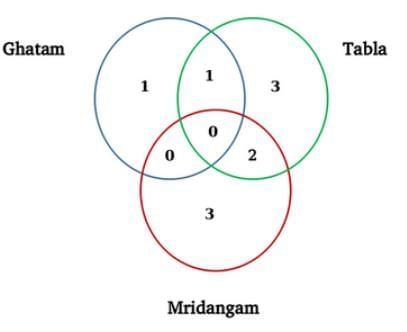
The conditions help us to further bifurcate the individuals based on their expertise.
Mridangam: A and B (condition 1); one out of F and G (condition 3)
Tabla: one out of A and B (condition 1); F and G (condition 3); D (condition 2)
Ghatam: D (condition 2)
Based on condition 4, we infer that 'I' and 'J' are either experts in Ghatam or Mridangam. However, condition 5 adds that 'I' is not an expert in Mridangam. This helps us definitively zero-in on 'I' as an expert in Ghatam. Since 'I' is a Ghatam expert, J is an expert in Mridangam and 'H' is an expert in Tabla [based on conditions 4 and 5]. Thus, we can depict our understanding so far as follows: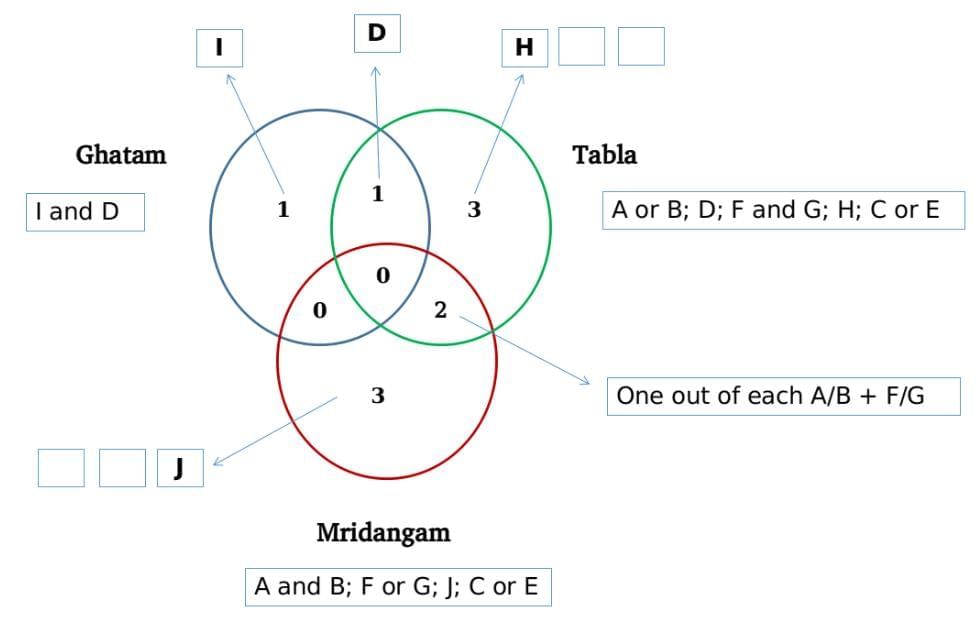
Mridangam [total: 5] - A and B (condition 1); one out of F and G (condition 3); J (condition 4 and 5); one out of C and E {remaining experts}
Tabla [total: 6] - one out of A and B (condition 1); F and G (condition 3); D (condition 2); H (condition 4 and 5); one out of C and E {remaining experts}
Ghatam [total: 2] - D (condition 2); I (condition 4 and 5)
Thus, we observe that H is definitely an expert in tabla but not in either mridangam or ghatam. Hence, Option (d) is the correct answer.
Q2: Who among the following is DEFINITELY an expert in mridangam but not in either tabla or ghatam?
(a) B
(b) J
(c) G
(d) E
 View Answer
View Answer 
Ans: (b)
Based on the given information, we can form the following Venn-diagram for ease of understanding: 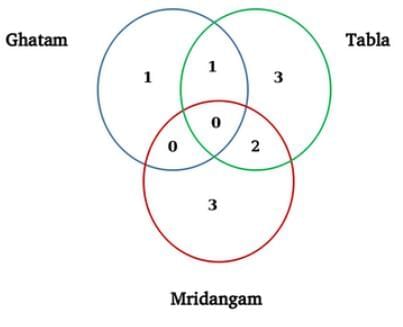
The conditions help us to further bifurcate the individuals based on their expertise.
Mridangam: A and B (condition 1); one out of F and G (condition 3)
Tabla: one out of A and B (condition 1); F and G (condition 3); D (condition 2)
Ghatam: D (condition 2)
Based on condition 4, we infer that 'I' and 'J' are either experts in Ghatam or Mridangam. However, condition 5 adds that 'I' is not an expert in Mridangam. This helps us definitively zero-in on 'I' as an expert in Ghatam. Since 'I' is a Ghatam expert, J is an expert in Mridangam and 'H' is an expert in Tabla [based on conditions 4 and 5]. Thus, we can depict our understanding so far as follows: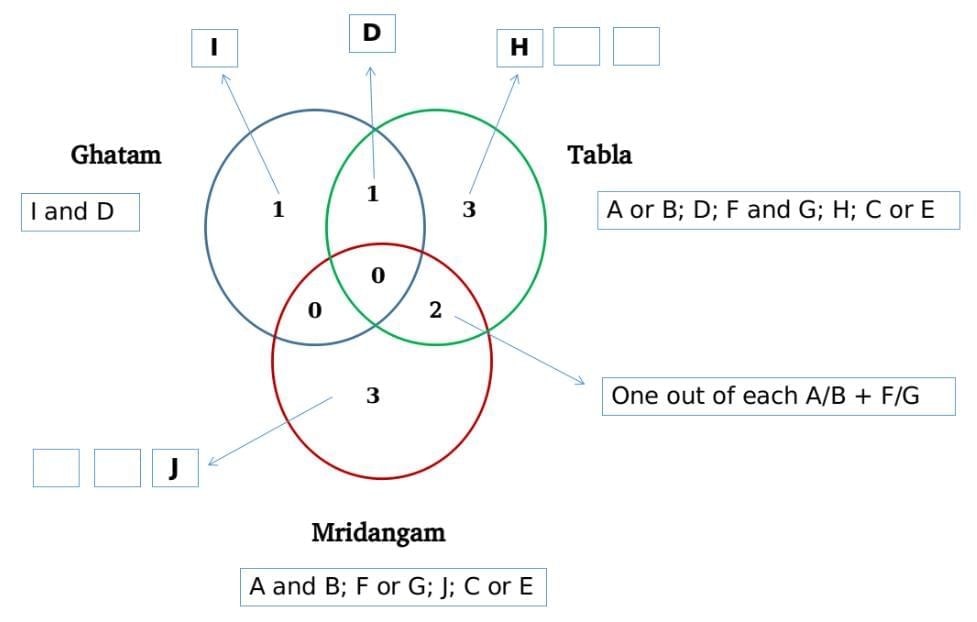
Mridangam [total: 5] - A and B (condition 1); one out of F and G (condition 3); J (condition 4 and 5); one out of C and E {remaining experts}
Tabla [total: 6] - one out of A and B (condition 1); F and G (condition 3); D (condition 2); H (condition 4 and 5); one out of C and E {remaining experts}
Ghatam [total: 2] - D (condition 2); I (condition 4 and 5)
Thus, we observe that J is definitely an expert in mridangam but not in either tabla or ghatam. Hence, Option (b) is the correct answer.
Q3: Which of the following pairs CANNOT have any musician who is an expert in both tabla and mridangam but not in ghatam?
(a) F and G
(b) C and E
(c) A and B
(d) C and F
 View Answer
View Answer 
Ans: (b)
Based on the given information, we can form the following Venn-diagram for ease of understanding: 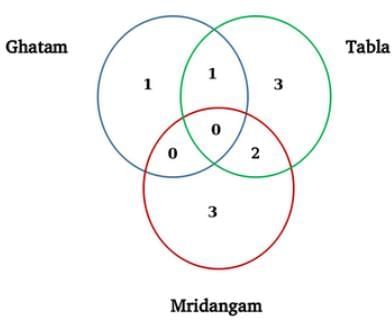
The conditions help us to further bifurcate the individuals based on their expertise.
Mridangam: A and B (condition 1); one out of F and G (condition 3)
Tabla: one out of A and B (condition 1); F and G (condition 3); D (condition 2)
Ghatam: D (condition 2)
Based on condition 4, we infer that 'I' and 'J' are either experts in Ghatam or Mridangam. However, condition 5 adds that 'I' is not an expert in Mridangam. This helps us definitively zero-in on 'I' as an expert in Ghatam. Since 'I' is a Ghatam expert, J is an expert in Mridangam and 'H' is an expert in Tabla [based on conditions 4 and 5]. Thus, we can depict our understanding so far as follows:
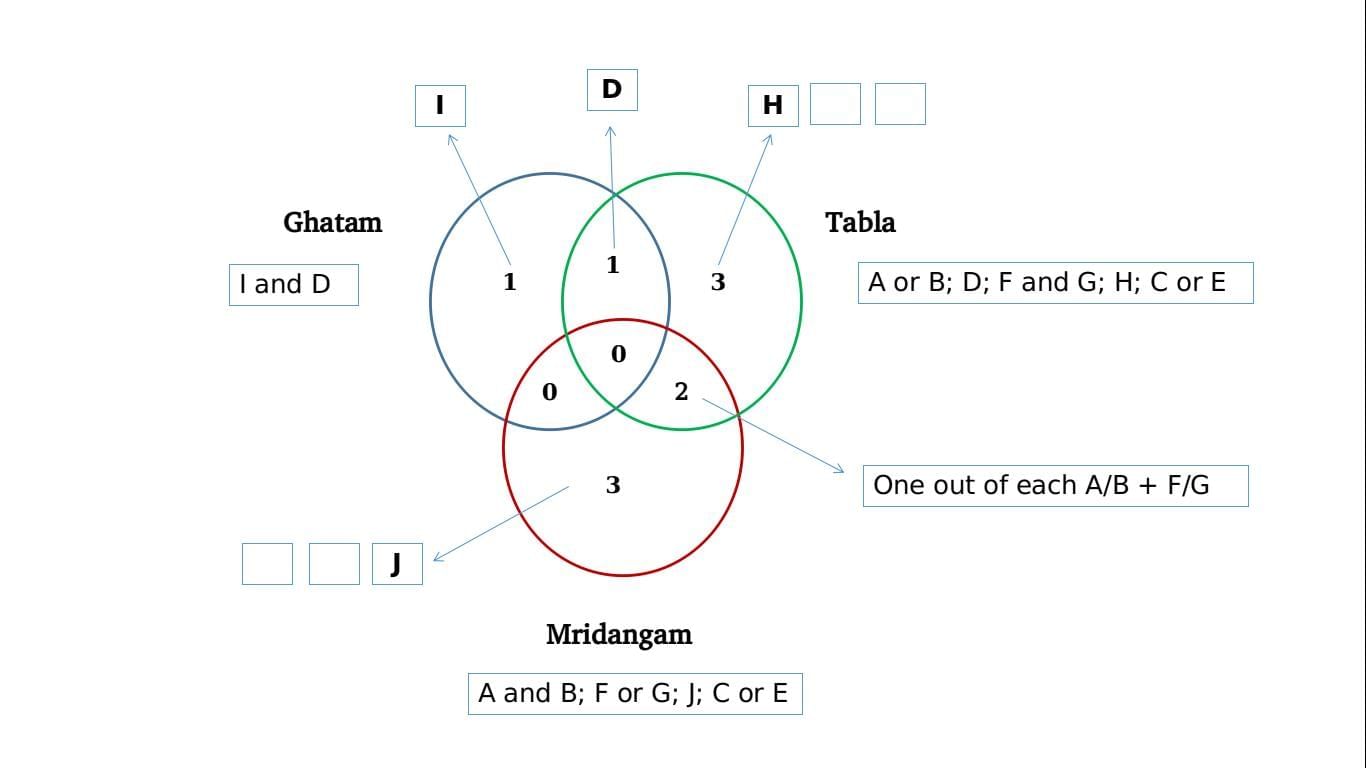
Mridangam [total: 5] - A and B (condition 1); one out of F and G (condition 3); J (condition 4 and 5); one out of C and E {remaining experts}
Tabla [total: 6] - one out of A and B (condition 1); F and G (condition 3); D (condition 2); H (condition 4 and 5); one out of C and E {remaining experts}
Ghatam [total: 2] - D (condition 2); I (condition 4 and 5)
We observe that the pair C and E cannot have any musician who is an expert in both tabla and mridangam but not in ghatam. Hence, Option (b) is the correct answer.
Q4: If C is an expert in mridangam and F is not, then which are the three musicians who are experts in tabla but not in either mridangam or ghatam?
(a) E, F and H
(b) C, G and H
(c) E, G and H
(d) C, E and G
 View Answer
View Answer 
Ans: (a)
Based on the given information, we can form the following Venn-diagram for ease of understanding: 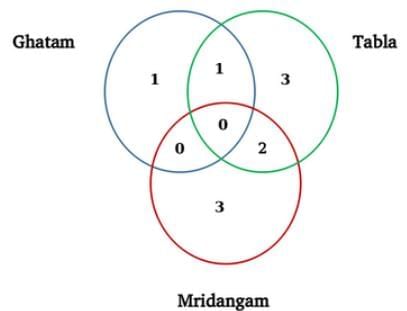
The conditions help us to further bifurcate the individuals based on their expertise.
Mridangam: A and B (condition 1); one out of F and G (condition 3)
Tabla: one out of A and B (condition 1); F and G (condition 3); D (condition 2)
Ghatam: D (condition 2)
Based on condition 4, we infer that 'I' and 'J' are either experts in Ghatam or Mridangam. However, condition 5 adds that 'I' is not an expert in Mridangam. This helps us definitively zero-in on 'I' as an expert in Ghatam. Since 'I' is a Ghatam expert, J is an expert in Mridangam and 'H' is an expert in Tabla [based on conditions 4 and 5]. Thus, we can depict our understanding so far as follows:
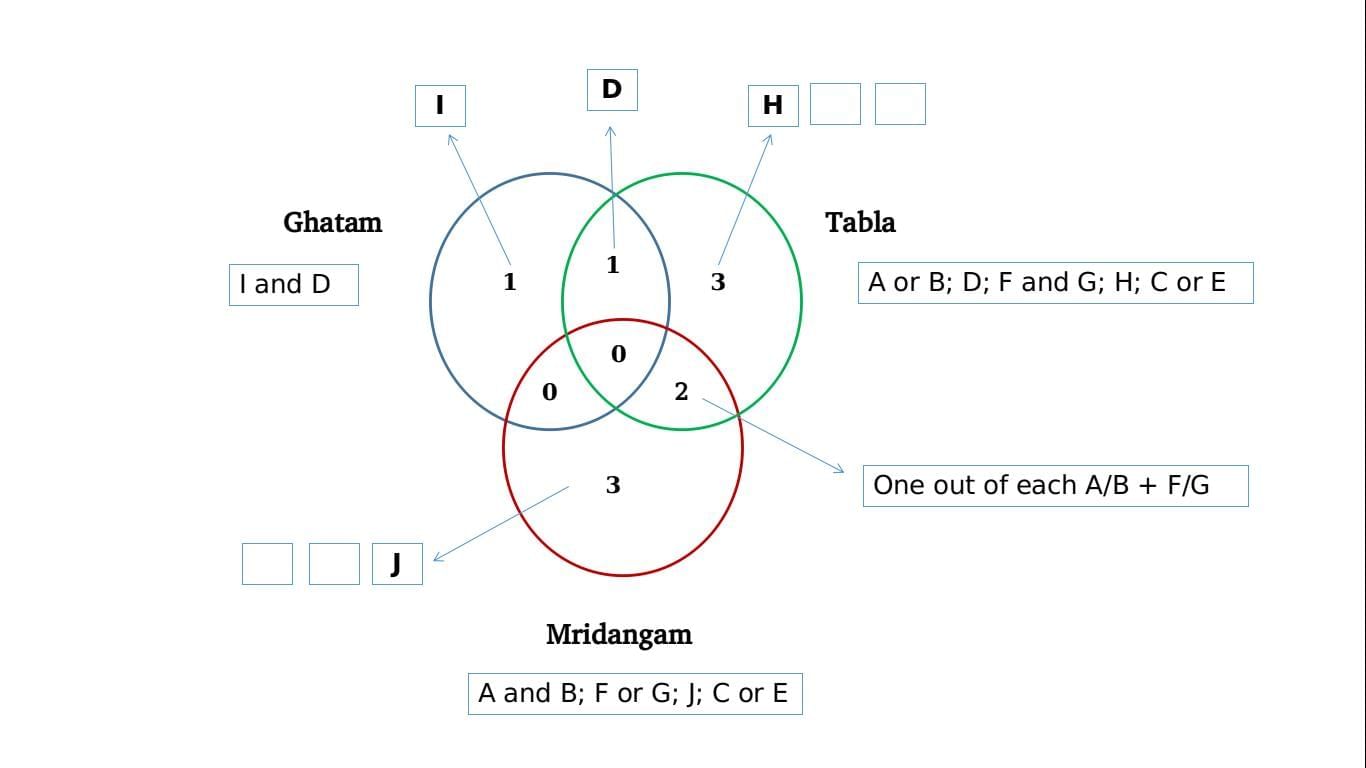
Mridangam [total: 5] - A and B (condition 1); one out of F and G (condition 3); J (condition 4 and 5); one out of C and E {remaining experts}
Tabla [total: 6] - one out of A and B (condition 1); F and G (condition 3); D (condition 2); H (condition 4 and 5); one out of C and E {remaining experts}
Ghatam [total: 2] - D (condition 2); I (condition 4 and 5)
If C is an expert in Mridangam, E has to be an expert in Tabla. Additionally, if F is not an expert in Mridangam, he has to be an expert only in Tabla while G will be an expert in both Tabla and Mridangam.
Tabla [total: 6] - one out of A and B (condition 1); F and G (condition 3); D (condition 2); H (condition 4 and 5); E {based on the condition given in the question}
Of these experts, A, B and G are experts of Mridangam and D is an expert of Ghatam as well. Thus, excluding these, we have F, H and E who are the experts solely in Tabla. Thus, Option (a) is the correct answer.
|
102 videos|123 docs|121 tests
|
FAQs on Practice Question - 14 (Venn Diagram) - 100 DILR Questions for CAT Preparation
| 1. What is a Venn Diagram and how is it used in problem-solving? |  |
| 2. How can Venn Diagrams be applied in competitive exams like CAT? |  |
| 3. What types of questions can be solved using Venn Diagrams in exams? |  |
| 4. Are there any strategies for effectively interpreting Venn Diagrams during exams? |  |
| 5. What are common mistakes to avoid when using Venn Diagrams in problem-solving? |  |















